2.3. Impact of excise tax increase on consumption, government revenue and smuggling
(by the International Centre for Political Studies)
The primary purpose of this study is to determine the influence of Ukraine government’s excise policy in the tobacco industry on consumption of cigarettes and excise tax proceeds. Hence, we performed econometric estimations of three major equations for Ukraine’s tobacco industry: the demand function, the price equation, and the Laffer curve.
The demand function shows the relationship between cigarette consumption on the one hand, and cigarette price and other factors affecting demand on the other. Among other factors we included consumer income, in order to determine the income elasticity of demand, and a special variable that allows determining the impact of excise policy on the volume of smuggling into Ukraine.
The price equation allows to determine major factors affecting cigarette prices in Ukraine. Here, the price is expressed as a function of the excise rate and the UAH/USD exchange rate, where the latter is used as a proxy for the cost of the major imported input (i.e. raw tobacco) in the production process. Given the demand function, the price equation allows determining the relationship between the excise rate and demand for cigarettes.
Finally, the Laffer curve is used to estimate the relationship between the excise rate and excise tax proceeds. In our analysis we are not dealing with choosing an optimal tax type for cigarettes. The purpose of our analysis is to evaluate the current excise taxation policy in Ukraine and provide some policy options regarding the excise rate in the existing framework. Thus, throughout the text we stick to the specific taxation system and assume that the government will not change the system in the nearest future.
According to economic theory, initially, higher tax rates lead to increased tax proceeds, while after a certain point (a maximum) the revenues fall if the tax rate is increased.
While estimating the described equations we used time-series monthly data for the period from January 1998 till June 2001. In all cases when monetary indicators are used they are measured in real terms (i.e. inflation adjusted). The data comes from the State Statistics Committee, the National Bank of Ukraine, and Ukraine’s legislation
2.3.1 Demand function and price equation
The purpose of estimating the demand function is to determine the price and income elasticity of the cigarette demand. All estimates are performed at the macro-level meaning that we used aggregate variables for the whole industry.
The price equation regresses cigarette price on instruments to explain price movements, including the inflation adjusted UAH/USD exchange rate and the weighted average excise rate. Also the price time-series was found to be integrated of order 1, so we use AR error correction process. By doing so we also gain in ability to distinguish between long-run and short-run price movements.
The dependent variable is the inflation adjusted average price of cigarettes (see Figure 2.3.1). Here and then we use CPI to adjust for inflation (1997 is a base year). The price is the weighted average of filtered and non-filtered cigarette prices. Quarterly weights of cigarette production were applied.
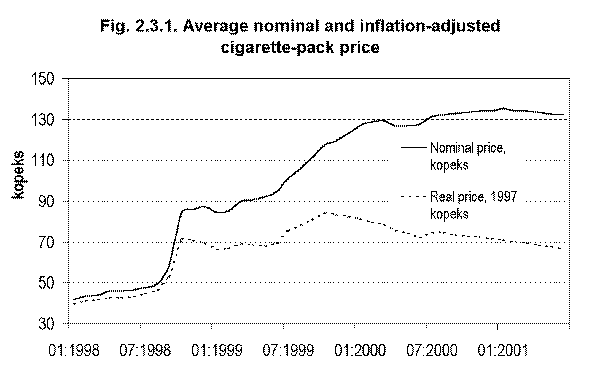
Exchange rate is the Hryvna/US dollar average exchange rate, adjusted for inflation, and lagged one period. There are several possible explanations for including this variable. As the exchange rate changes, so does the domestic price of imported raw tobacco used in production of cigarettes. Also we expect the cost to change gradually starting with one lag, presuming the existence of domestic stock of raw materials i.e. tobacco. On the other hand, multinational cigarette producers operating in Ukraine are interested in foreign currency receipts, thus they may adjust prices to exchange rate changes.
Ukrainian excise rate series originates from legislation. The excise rate used in our estimations represents the weighted average of excise rates for filtered and non-filtered cigarettes. Shares of filtered and non-filtered cigarettes in production were used as weights. We use inflation-adjusted version because we model the inflation-adjusted price of cigarettes.
In the demand equation quantity demanded is regressed on price, determined simultaneously from the previous equation, real household disposable income, smuggling proxy and four dummy variables representing producer expectations.
Due to the lack of reliable and contingent data on cigarette consumption in Ukraine, we were forced to use Ukrainian production data with adjustment to include imports and exclude exports as a dependent variable. However, there exist a substantial smuggling of cigarettes into Ukraine. We attempt to control the smuggling efforts using a proxy variable. As was noted in previous research (see, for example, ICPS, 2000, “Causes and effects of illegal tobacco import and circulation in Ukraine”), bootlegging accounts for the majority of smuggling efforts. This is explained by the rather transparent borders between Ukraine and its neighboring countries.
To eliminate the bias in price elasticity of demand due to smuggling we include the so-called “incentive variable” proxy. This incentive variable is represented by the ratio of excise tax rates in two neighboring countries. Hence, it measures the potential profit from smuggling. It is assumed that cigarettes in the two countries are of similar quality (which is true for Ukraine and its neighboring countries) and the only factor that causes smuggling is the tax differential. The larger is the potential profit, the more incentives will smugglers have to bring illegal products to the country with higher taxes. In the case of Ukraine, majority of illegal products comes from Russia.
One peculiarity of smuggling is that it takes time for smugglers to identify the difference or change in taxes (and hence, prices) and to establish channels for distribution of illegal products. Consequently, some time will pass before the change in potential profits will influence the volume of smuggling. Experts estimate average lag to 4-5 months.
Besides, consumers may be “brand-addicted”. This means that a consumer is used to smoking a particular cigarette brand. Hence, if his “favourite” brand becomes relatively more expensive, the consumer may not switch to other cheaper (smuggled) brands immediately. Instead, the consumer will look for a smuggled brand that is more close to his taste. This process will take some time, and the consumer will switch to smuggled cigarettes after a certain period of time.
Under such modification we presume that the equation reflects changes in quantity demanded more accurately. For instance, if Ukrainian excise rate grows (leading to higher domestic price), legal domestic sales will fall due to reduction in cigarette consumption and/or consumer switching to cheaper smuggled cigarettes. Consequently, since smuggling is controlled using the incentive variable, we nevertheless can obtain correct price elasticity of demand. The coefficient of the price shows changes in domestic sales due to reduced consumption, while the coefficient of the incentive variable reflects changes in domestic sales due to smuggling.
Real household income is the household cash disposable income deflated by the CPI. Sales are usually expected to be inelastic in this variable as it typically happen in medium and high-income countries. However, the relationship may be significant because incomes reported in Ukraine are relatively low.
Dummy variables were introduced to capture the spike of domestic sales of high magnitude in the first month of 2001 and the dip in the last month of 2000. The same approach was applied in June-July of 2000. This behavior could be explained by the expectations of domestic producers about the changes in excise rate. The first dummy is set to 1 for the month before the change in excise rate was agreed, and the second dummy is introduced immediately after that. The producers might lower their output and restore after the successive outcome had approved.
The demand for cigarettes was estimated using simultaneous equations approach. The system consists of two equations for price and demand respectively. Specifically, Seemingly Unrelated Regression technique was applied in attempt to resolve endogeneity problem of price determination. All equations are specified in logs to smooth outstanding spikes and prevent heteroskedasticity and autocorrelation in errors.
2.3.2. Laffer curve
After determining factors influencing cigarette demand, we can turn to deriving the relationship between the excise rate and budget revenues. The concept we use is known as the Laffer curve. According to the theory, when the tax rate is increased tax revenues grow up to a certain point. At this point, tax revenues are maximized and further increase in the tax rate will reduce tax revenues. Hence, we apply this model to Ukrainian tobacco industry.
Due to the indicated features of the Laffer curve, the equation describing the model cannot be linear because as the theory predicts, the corresponding curve slopes upward, reaches its maximum, and, finally, declines.
The dependent variable is excise tax revenue, which can be calculated given that Ukraine has specific excise taxation. In particular, this is calculated as the excise rate multiplied by domestic sales of cigarettes. Domestic sales are calculated as domestic production minus exports plus imports. In Ukraine, excise is paid from domestic sales only.
Tax revenues naturally depend on the tax rate. However, on the other hand, revenues are influenced by the demand. If taxes are raised significantly, the price of the taxed good is likely to grow causing the demand to shrink.
Consequently, in addition to the excise rate, there is a need to control some explanatory variables that influence the demand for legal cigarettes. In particular, as was described above, if smuggling is not taken into account, the estimated coefficients are likely to be biased. Hence, in order to estimate “pure” effect of the excise rate on tax revenues, the incentive variable is included as an additional regressor. This will be included in the same form as in the demand function (discussed above).
To make the model complete, we include other factors influencing cigarette demand. These are real household income, the exchange rate of the hryvnia with respect to the US dollar, and the set of dummy variables discussed above. The OLS method is used to perform econometric estimation.
We now turn to discussing the results of estimations performed.
2.3.3. Estimation results
Demand function and price equation
Having performed econometric estimation we came to the following results.
All coefficients were found significant at least at 5% significance level. Price equation regressors determine about 98% of variance in real price, possessing R2 of 0.976. Demand equation has an R2 equal to 0.67, meaning 67% of domestic sales variance is captured by the equation. Durbin-Watson statistics of about 1.4 in demand equation indicates small and tolerable autocorrelation in residuals, while the DW-statistics equals 2.07 for the price equation, which gives evidence of no autocorrelation in respective residuals.
The elasticity of cigarette demand in Ukraine with respect to cigarette price equals approximately –0.25. This means that a ten-percent increase in the real price causes a 2.5-percent decrease in cigarette demand. The income elasticity of cigarette demand is found to be positive and equal to 0.47. This can be interpreted in the following way: a ten-percent increase in the real disposable household income leads to a 4.7-percent increase in cigarette demand. Hence, as incomes of Ukrainians grow they will consume more cigarettes.
Note also that changes in the excise rate have only moderate effect on the volume of cigarette smuggling. As described earlier, we included the so-called incentive variable. Our estimates support the lag specification argued above. Specifically, changes in potential profits from smuggling affect domestic sales after 4 month. We found that a ten-percent increase in the ratio of excise rates in Ukraine and Russia leads to approximately 0.8-percent drop in legal domestic sales, which is caused by increased smuggling. Alternatively, this means that a ten percent increase in the Ukrainian excise rate (given an unchanged excise rate in Russia) leads to a 0.8-percent drop in legal domestic sales due to growing smuggling. However, changes in the volume of smuggling may be caused by other factors not captured by our model.
From the price equation, we found that a ten-percent increase in the excise rate leads to a 1.2-percent increase in cigarette prices in the short run. Given the demand function, we can conclude that such an increase in the excise rate will result in a 0.3-percent decrease in the demand in the short run. However, in the long run, the demand will fall by 2.5 percent, given the presence of AR component in the price equation.
The elasticity of the price with respect to UAH/USD exchange rate equals 0.46. This means that a ten-percent depreciation of the hryvnia will result in a 4.6-percent increase in the average cigarette price.
Laffer curve
As our estimates show, the Laffer curve for the tobacco industry (see Figure 2.3.2) has the shape predicted by economic theory. It has one revenue-maximizing excise rate which is equal to approximately 11.3 constant 1997 hryvnias (in nominal terms as of June 2001 – approximately 22.3 hryvnias). Given that, for example in June 2001 the excise rate in Ukraine was equal to 4.5 constant 1997 hryvnias (in nominal terms as of June 2001 – approximately 8.9 hryvnias), Ukraine is on the upward-sloping portion of the Laffer curve. This means that higher excise rate will result in more budget revenues.
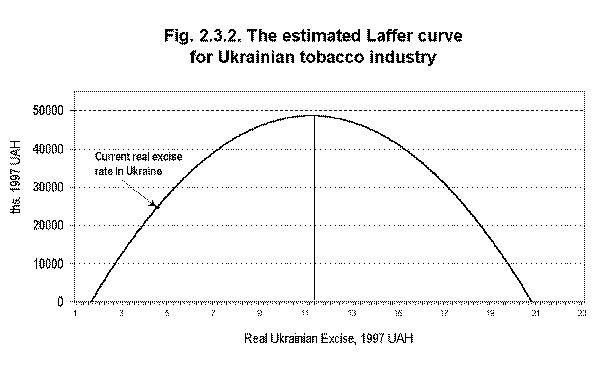
The specification has shown adequate econometric performance. Regressors included explain 92% of variance (R2 equals 0.916). All individual components are significant at least at 5% significance level, except for one dummy variable representing producer expectations, which is nevertheless significant at 8% significance level. DW statistics of 1.96 shows the absence of autocorrelation. White test for heteroskedasticity provide no evidence of this phenomena.
2.3.4. Policy implications
Having obtained the described estimates of the demand, price, and Laffer curve equations we can model some possible scenarios for the government, which is able to control only one variable in the model, i.e. the excise rate. Other exogenous variables are not changed through different scenarios.
Scenario 1. The government does not change the nominal excise rate
Such scenario represents our base-line forecast. Under this scenario, the government does not change its excise policy (i.e. nominal excise rate remains unchanged). While making our forecasts we assumed constant nominal UAH/USD exchange rate and nominal Russian excise rate for cigarettes. These variables are determined by policy actions made in Ukraine and Russia respectively. At the same time, we estimated trends in the CPI and disposable household income. Hence, for future years, these variables were projected according to this trend.
Scenario 2. The government increases the excise rate by 150% (up to the theoretical revenue-maximizing level) as of October 2001
We compare forecasts under this scenario with the base-line forecast, under which the government makes no changes to the existing excise policy.
Using the estimated equations we simulated domestic sales of cigarettes, price expressed in constant 1997 hryvnias, and excise tax proceeds. We obtained the following results (see Figures 2.3.3, 4, 5)
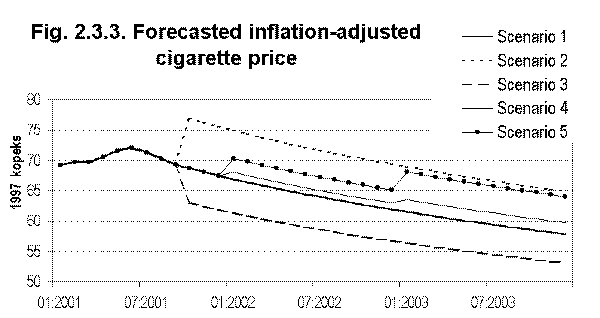
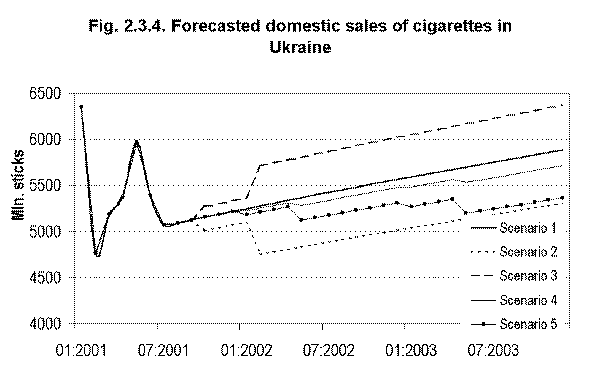
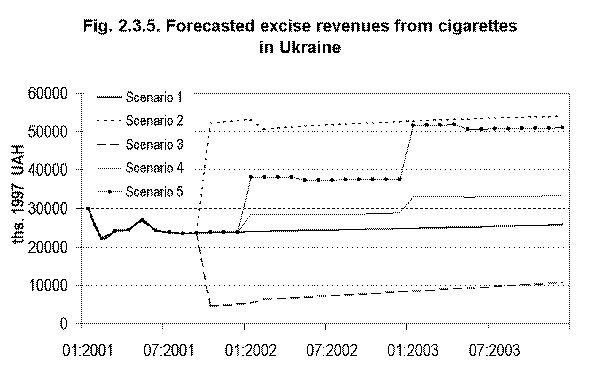
As the graphs show, the excise increase leads to an immediate growth in the price, which stays higher during the forecast period compared to the base-line forecast. The gradual decline in prices measured in constant 1997 hryvnias under both scenarios can be explained by the projected growth in CPI (i.e. moderate inflation). Figure 2.3.4 shows dynamics of domestic sales.
Due to the price increase (see Figure 2.3.3) caused by the excise rate growth domestic sales will fall, which is partially explained by reduced consumption and increased smuggling. We now turn to analyzing fiscal consequences of the scenario under consideration.
As we see from the graph (Figure 2.3.5), excise proceeds will grow and stay at higher level compared to the base-line forecast. Also note that excise proceeds under the considered scenario are approximately two times higher as compared to the base-line forecast.
Scenario 3. The government decreases excise rate by 50% as of October 2001
As Figures 2.3.3 and 2.3.4 indicate, under this scenario, cigarette prices are lower, while domestic sales are higher compared to both scenarios discussed above. At the same time, excise revenues drop significantly, while they stay lower thereafter compared to the previous scenarios (Figure 2.3.5).
Scenario 4. The government adjusts excise rate annually, keeping real excise rate constant
Under this scenario, the government increases the excise rate annually, on January 1. The purpose of increasing the nominal excise rate is to maintain the inflation-adjusted excise rate at the level of January 2001. The simulation results can be seen in the graphs. Note that such policy ensures more excise revenues compared to scenario 1 (no changes) and 3 (excise decrease).
Scenario 5. The government increases the excise rate twice, by 50% at the beginning of 2002 and 2003
This scenario is similar to Scenario 2, except for the gradual change in level of the excise rate. Under this scenario, the government increases the excise rate by 50% twice, on January 1, 2002, and January 1, 2003. As we can see from figures 2-4, by the end of the forecast period we reach almost the same results in terms of domestic sales, price and budget revenues as under Scenario 2. Cumulative increase in the excise rate equals 125% over the forecast period (which is lower than theoretically predicted level of the excise rate). However, the magnitude of annual changes is lower, compared to the 2nd scenario. Thus this scenario may be more politically acceptable since it doesn’t require one-time dramatic jump in the excise rate.
2.3.5. Conclusions
| Demand for cigarettes is sensitive to changes in the excise rate (although it is inelastic). Short-run elasticity equals -0.03, while long-run elasticity equals -0.25. | |
| Higher excise rates increase smuggling due to increased illegal profits. However, the effect is moderate: a ten-percent increase in the excise rate leads to a 0.8-percent decrease in legal domestic sales due to growing smuggling. | |
| Higher household incomes lead to increased demand for cigarettes. | |
| Changes in factors affecting demand except for price and excise rate (i.e. household incomes, UAH/USD exchange rate), will move both demand and excise revenues in the same direction (both grow, or both fall). | |
| Excise rates in Ukraine are lower compared to the theoretically predicted revenue-maximizing level, which is approximately 22.7 UAH at 2001 prices. | |
| Increased excise rates will result in higher tax proceeds. According to our model, excise proceeds will grow if the average excise rate is increased. Hence, this can be achieved by either increasing excise rate for filter, or non-filter cigarettes, or both. |
| Who we are? |
|
|
|
|
|
|
|
|
|
|
|
|
|
|